| |
At first sight, the building was totally unsuitable
for the purposes of a radio station. Lots of small interlinked rooms
with little or no soundproofing between them.
While in the process of demolishing the interior walls, a serious
damp problem was discovered along the entire back wall of the building
which required damp proofing treatment before further work could
be undertaken. Even after a damp proof course was installed, the
problem still persisted and a trench was dug around 3 sides of the
building to alleviate the problem. This hold-up added another 3
months to the time the whole project was to take.
During this phase, many tons of rubbish were generated all of which
was carried out of the building to be taken away in skips.
Most of the interior walls were of simple wood and plaster-board
construction, but one or two were solid brick and concrete necessitating
the use of more ambitious wrecking equipment! |
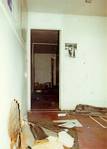
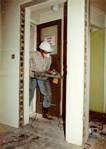
|
| |
The end result was an empty shell measuring
some 100 feet long by only 8 feet wide - more resembling a single
lane bowling alley than a modern radio studio!
Once the inside of the building had been completely cleared, a
chemical damp proof course was installed along the entire length
of the building. This was to prove a needless expense.
At this stage, construction of the studio walls at the west end
of the building had begun. There were already problems finding storage
for building materials.
The ventilation pipes run the entire length of the building extracting
stale air and injecting fresh air into the studios. |
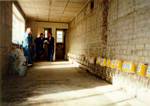
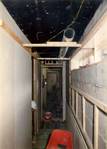
|
| |
The framework for the special double skinned
studio walls in the early stage of construction at the west end
of the building.
Special soundproof walls were built to a BBC specification for
radio studios. Two separate walls are built only inches apart to
give the solid mass necessary movement to stop any noise escaping.
Both walls have alternate layers of plasterboard and fibre board
which are then sealed along the edges and seams to make them completely
airtight.
So much piping was installed for this purpose, that for a period
of time before it was all boxed in and hidden, the building was
appropriately nicknamed the Pompidou Centre. |
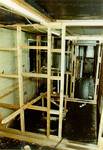
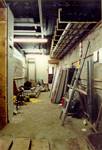
|
| |
Most of the windows were bricked up from the
inside, not only to increase the soundproofing in the studio areas,
but also to improve the security of the building.
Completely new electrical wiring was installed throughout the building
with separate circuits for lighting and heating with special extra
circuits for the broadcasting equipment.
The floors in each room were laid on special sound absorbing material
which help to reduce the transmission of noise between different
rooms.
Dense slabs of soundproofing material, which would later be covered
with decorative hessian panels, were secured to the walls in the
studios and cubicles. |
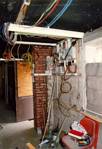
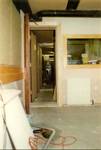
|
| |
An essential feature of radio studios is a
ventilation system. Here, the main input and output pipes have been
fitted to provide an efficient flow of fresh air to the building.
Finally, double glazed units were fitted into the window apertures
in both walls and these too were carefully sealed with mastic to
ensure an airtight fit.
Dense slabs of soundproofing material, which would later be covered
with decorative hessian panels, were secured to the walls in the
studios and cubicles.
Special soundproofing panels were manufactured to cover the ceilings
and walls in the studio areas. The first step was to make sure the
hessian material was wrinkle free. |
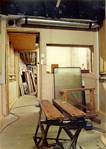

|
| |
The next step was to stretch the hessian tightly
over a wooden frame and staple it securely in place.
Finally the frame was drilled and secured to the walls and ceilings
in the exact position to cover the dense slabs of soundproofing
material which had been positioned earlier.
Finally the frame was drilled and secured to the walls and ceilings
in the exact position to cover the dense slabs of soundproofing
material which had been positioned earlier.
The work needed on the building either sharpened some of our members'
skills or gave them good practice for the next time they indulged
in DIY at home! |
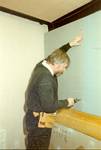
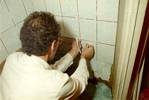
|
| |
Record shelves, custom built by two of our
members in a garage, were installed in the office cum record library
ready to receive the E.H.B.S. record collection.
With all the construction work, electrical work and decorating
etc. finished, the last remaining task is to install and wire up
all the broadcasting equipment in the studios.
New sound mixing desks, although professionally made, still require
a great deal of work to adapt them for the unique demands of hospital
radio broadcasting.
The chairman receiving a cheque from Jacqui Dove on behalf of the
BT employees' charities fund for a digital disk recorder to allow
high quality prerecording programmes to be produced and presented
on Red Dot Radio. |
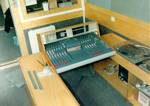
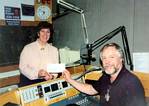
|
| |
Just a few seconds after Red Dot Radio goes
on-air for the very first time and the Technical Director operates
the studio equipment for the presenter in the adjoining cubicle.
The chairman had the dubious honour of being the first programme
presenter at 7pm on that first night as he presented "Across
the Decades" featuring music from the 1950's.
As the button is pressed, the red light glows to show that Red
Dot Radio is finally "on-air".
At the end of the first night's programmes from Red Dot Radio,
the team responsible pose for a well-deserved photo-call to mark
the occasion. |
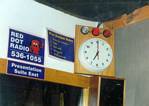
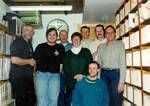
|
| |
|
|
|
....And 11 years later
|
|
|
Chris and Rupert presenting and listening.
Malcolm, the technical director, and master presenter, still has
control of the desk. Honestly he does have a home to go to!
Just look at that slider action!
|
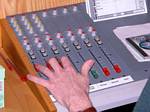 |
| |
|
|